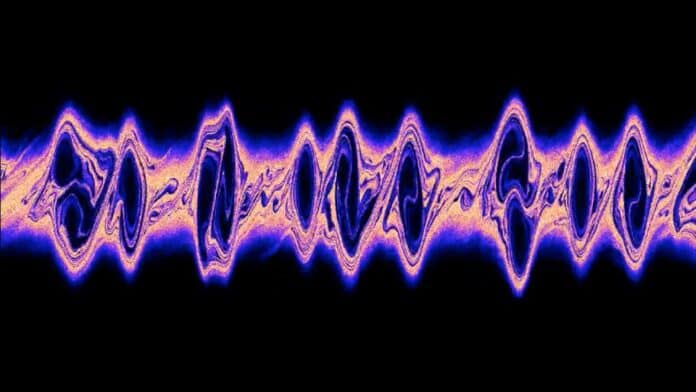Most astrophysical plasmas are likely to be permeated with cosmic rays; these include protoplanetary disks and the interstellar, circumgalactic, and intracluster media. In the Milky Way, the cosmic ray energy density is equipped with the average thermal and magnetic energy densities.
Hence, as demonstrated in one-dimensional models, these cosmic rays constitute an essential nonthermal component that provides dynamic feedback to the interstellar medium and can launch galaxy-scale outflows.
In a new study, Scientists from the Leibniz Institute for Astrophysics Potsdam (AIP) have discovered a further plasma instability that promises to revolutionize our understanding of the origin of cosmic rays and their dynamic impact on galaxies.
Scientists studied the underlying physics of cosmic-ray-driven instabilities that have a key role in CR transport across various scales, from interstellar to galaxy cluster environments.
Scientists used computer simulations to track the paths of many cosmic ray particles and see how they interact with the surrounding plasma of electrons and protons. They found something new when they looked at cosmic rays moving from one side of the simulation to the other. These cosmic rays cause electromagnetic waves in the plasma around them. These waves then push the cosmic rays, changing the way they move.
The critical thing to understand here is that it’s better to think of cosmic rays not as individual particles but as a group supporting a collective electromagnetic wave. When this wave interacts with the basic waves in the background, it strengthens them, transferring energy.
Professor Christoph Pfrommer, head of the Cosmology and High-Energy Astrophysics section at AIP, said, “This insight allows us to consider cosmic rays as behaving like radiation and not individual particles in this context, just as it has been originally believed by Victor Hess.”
Dr. Mohamad Shalab said, “A good analogy for this behavior is individual water molecules collectively forming a wave that breaks at the shore. This progress only came about by considering smaller scales that have previously been overlooked and that question the use of effective hydrodynamic theories when studying plasma processes.”
Mohamad Shalaby said, “There are many applications of this newly discovered plasma instability, including a first explanation of how electrons from the thermal interstellar plasma can be accelerated to high energies at supernova remnants. This newly found plasma instability represents a significant leap in our understanding of the acceleration process and finally explains why these supernova remnants shine in the radio and gamma rays.”
“Moreover, this groundbreaking discovery opens the door to a deeper understanding of the fundamental processes of the transport of cosmic rays in galaxies, representing the greatest mystery in our understanding of the processes that shape galaxies during their cosmic evolution.”
Journal Reference:
- Mohamad Shalaby, Timon Thomas, Christoph Pfrommer, Rouven Lemmerz, and Virginia Bresci. Deciphering the physical basis of the intermediate-scale instability. arXiv (2023). DOI: 10.48550/arxiv.2305.18050
